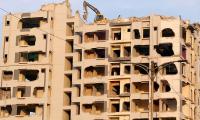LAHORE: Walled City of Lahore Authority would be launching a new tour namely Sikh Heritage Tour in which local and international tourists can freely visit Sikh heritage sites inside the walled city of Lahore.
The newly-designed tour included the historical sites of Janam Asthan of Guru Ram Das, Gurdwara Guru Arjan Dev Ji, Samadhi of Maharaja Ranjeet Singh, Samadhi of Kharak Singh and Samadhi of Nau Nehal Singh. Officials said the tour would be once a month on a Sunday and it will cost Rs1,500 per person.
Janam Asthan of 5th Sikh Guru Ram Das is located inside the Masti Gate of walled city Lahore whereas Gurdwara Guru Arjan Dev Ji, Samadhi of Maharaja Ranjeet Singh, Samadhi of Kharak Singh and Samadhi of Nau Nehal Singh are situated in Dera Sahib opposite Lahore Fort.
Tania Qureshi, Deputy Director Marketing, said that the tour would start from Fort Road Food Street from where the tourists would be taken on Rangeela Rickshaws to these sites along with a walking tour. “Sikh rulers ruled the walled city of Lahore and left their marks in the shape of majestic monuments. It is great to have such gems in Lahore and now we are planning to take the tourists to these sites. These sites are also a mark of religious tolerance and harmony that prevailed in Lahore during the past”, she said.
Asif Zaheer, Director Marketing and Tourism WCLA said, “It will be the first of its kind initiative as we will be having a Sikh tourist guide for this tour. We are already taking the tourists to Dera Sahib in the history by night tours but the day tours will be a completely new experience for the tourists as we will be showing the places in more detail.”
Giving historical facts about Gurdwara Guru Ram Das, Tania Qureshi said that the gurdwara is located in Chuna Mandi Bazaar in Masti Gate of Walled City, Lahore. Location of Janam Asthan is in close proximity of the Lahore Fort and Begum Shahi Mosque. The gurdwara can also be accessed from Royal Trail or Shahi Guzargah if anyone enters from Delhi Gate and take the straight passage towards Masti Gate. The entire trail has been restored by the Walled City of Lahore Authority and it’s a tourist hotspot, she added.
This mesmerising Sikh holy site was built at the site where it is traditionally believed was the birthplace and childhood home of Guru Ram Das who was the 4th Sikh Guru. The Walled City of Lahore Authority is also planning to remove encroachments from this area after which the building will become more prominent for tourists and people visiting the place.
Tania Qureshi said that the Gurdwara was built atop a white marble platform and one have to climb several steps to reach the Gurdwara. The shrine measures 122 feet 6 inches by 97 feet 6 inches. To the west of the shrine is an open courtyard, surrounded on two sides by a two-story building. It is built in white marble and decorated with pietra dura work, which was a tradition of beautifying the places in old times. It was one of the expensive mediums of structure décor. On the west of the building is an open yard and Nishan Sahib is fixed on the south-west corner.
The place is magnificently festooned and embellishments on the ceilings and walls are remarkable. The tourists will find a lot of pigeons there. Before entering the main hall, one would have to go for ablution. The place for ablution is constructed in one corner of the building. The Granth is also placed in the main hall, which is well-preserved and decorated with Sikh history.
Talking about the other above mentioned Sikh historical sites, she said Gurdwara Guru Arjan Dev Ji, Samadhi of Maharaja Ranjeet Singh, Samadhi of Kharak Singh and Samadhi of Nau Nehal Singh are situated in Dera Sahib opposite Lahore Fort.
The complex was constructed by Maharaja Ranjit Singh’s son, Kharak Singh, on the spot where Ranjit Singh was cremated and was completed by his youngest son, Duleep Singh, in 1848. It is a beautiful blend of Hindu, Sikh and Muslim architectural styles. Tania Qureshi said it had gilded fluted domes and cupolas and a complex railing round the top.
She explained that the front of the doorway has images of Ganesh, Devi and Brahma, the Hindu deities, cut in red sand stone. The dome is heavily decorated with Naga (serpent) hood designs, a rich and fitting tribute to Hindu craftsmanship. The wood panels on the ceiling are covered with stained glass work and the walls have rich floral designs.
She explained that the ceilings are decorated with glass mosaic work. Maharaja Ranjit Singh’s ashes are contained in a marble urn in the shape of a lotus, sheltered under a marble pavilion inlaid with pietra dura, in the centre of the tomb. She added that the Maharaja does not lie alone there. Surrounding him, in smaller knob-like urns, are the ashes of four sati queens (burned alive on the pyre with their husband) and seven slave girls. The ashes of two pigeons, burnt while flying over the pyre, also have their place in the Samadhi.
The Samadhi of Ranjit Singh is originally built on eight pillars. Due to depreciation of the building over time cracks appeared in the pillars. The British government, under the orders of Sir Donald Macleod, late Lieutenant-Governor of Punjab, erected thick iron rings around all the old pillars and raised eight additional pillars. The entire building is now supported by 16 pillars.
She added that some of the material used in the construction of this building was taken from the Mughal buildings, especially the Fort. The large marble door frame of the main entrance of the Samadhi, ornamented with pietra dura work was taken from the Sheesh Mahal of the Lahore Fort. Similarly, about 21 other marble door frames at different places in the building apparently also came from some other Mughal buildings in the Fort.
In the same complex are the Samadhis of Ranjit Singh’s son Kharak Singh and grandson Prince Nau Nihal Singh who had built the Haveli Nau Nihal Singh now known as Victoria High School inside Bhatti Gate. She concluded that it should be a tourist site, so that people from all religions can visit it.
Minister for Mines & Minerals Sardar Sher Ali Gorchani seen in this image on April 1, 2024. — Facebook/Sardar Sher...
This photograph shows students attending a class at a school on the outskirts of Lahore. — AFP/FileLAHORE:Department...
Lahore Waste Management Company workers cleaning the streets. — APP/FileLAHORE:Lahore Waste Management Company has...
UHS Vice Chancellor Prof Ahsan Waheed Rathore sits during a meeting. — X/@uhslhrofficial/File LAHORE:The 79th...
This image shows Punjab police personnel standing alert. — AFP/FileLAHORE:On the instructions of Director General...
Representational image showing dark clouds. — PPI/FileLAHORE:Partly cloudy weather with hot and humid conditions was...







